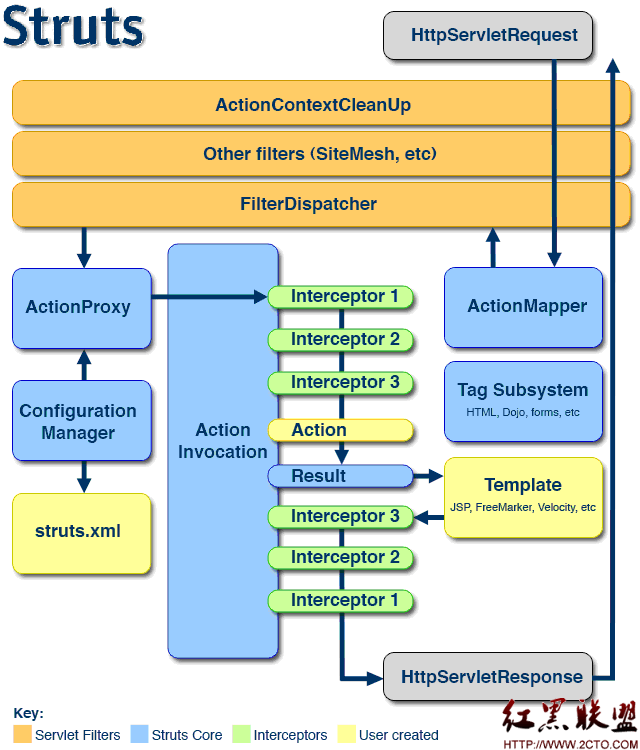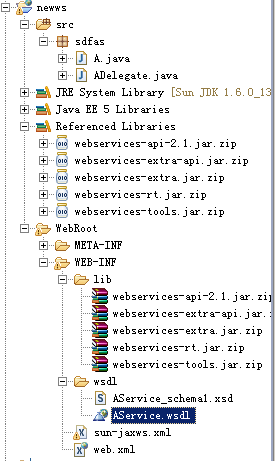Struts2体系结构图以及详解
Strut2的体系结构如图所示:
一个请求在Struts2框架中的处理大概分为以下几个步骤:
1、客户端初始化一个指向Servlet容器(例如Tomcat)的请求;
2、这个请求经过一系列的过滤器(Filter)(这些过滤器中有一个叫做ActionContextCleanUp的可选过滤器,这个过滤器对于Struts2和其他框架的集成很有帮助,例如:SiteMesh Plugin);
3、接着FilterDispatcher被调用,FilterDispatcher询问ActionMapper来决定这个请求是否需要调用某个Action;
4、如果ActionMapper决定需要调用某个Action,FilterDispatcher把请求的处理交给ActionProxy;
5、ActionProxy通过Configuration Manager询问框架的配置文件,找到需要调用的Action类;
6、ActionProxy创建一个ActionInvocation的实例。
7、ActionInvocation实例使用命名模式来调用,在调用Action的过程前后,涉及到相关拦截器(Intercepter)的调用。
8、一旦Action执行完毕,ActionInvocation负责根据struts.xml中的配置找到对应的返回结果。返回结果通常是(但不总是,也可能是另外的一个Action链)一个需要被表示的JSP或者FreeMarker的模版。在表示的过程中可以使用Struts2框架中继承的标签。在这个过程中需要涉及到ActionMapper。
FilterDispatcher是控制器的核心,就是mvc中c控制层的核心。下面粗略的分析下我理解的FilterDispatcher工作流程和原理:FilterDispatcher进行初始化并启用核心doFilter
其代码如下:
[java]
1. public void doFilter(ServletRequest req, ServletResponse res, FilterChain chain) throws IOException, ServletException ...{
2. HttpServletRequest request = (HttpServletRequest) req;
3. HttpServletResponse response = (HttpServletResponse) res;
4. ServletContext servletContext = filterConfig.getServletContext();
5. // 在这里处理了HttpServletRequest和HttpServletResponse。
6. DispatcherUtils du = DispatcherUtils.getInstance();
7. du.prepare(request, response);//正如这个方法名字一样进行locale、encoding以及特殊request parameters设置
8. try ...{
9. request = du.wrapRequest(request, servletContext);//对request进行包装
10. } catch (IOException e) ...{
11. String message = "Could not wrap servlet request with MultipartRequestWrapper!";
12. LOG.error(message, e);
13. throw new ServletException(message, e);
14. }
15. ActionMapperIF mapper = ActionMapperFactory.getMapper();//得到action的mapper
16. ActionMapping mapping = mapper.getMapping(request);// 得到action 的 mapping
17. if (mapping == null) ...{
18. // there is no action in this request, should we look for a static resource?
19. String resourcePath = RequestUtils.getServletPath(request);
20. if ("".equals(resourcePath) && null != request.getPathInfo()) ...{
21. resourcePath = request.getPathInfo();
22. }
23. if ("true".equals(Configuration.get(WebWorkConstants.WEBWORK_SERVE_STATIC_CONTENT))
24. && resourcePath.startsWith("/webwork")) ...{
25. String name = resourcePath.substring("/webwork".length());
26. findStaticResource(name, response);
27. } else ...{
28. // this is a normal request, let it pass through
29. chain.doFilter(request, response);
30. }
31. // WW did its job here
32. return;
33. }
34. Object o = null;
35. try ...{
36. //setupContainer(request);
37. o = beforeActionInvocation(request, servletContext);
38. //整个框架最最核心的方法,下面分析
39. du.serviceAction(request, response, servletContext, mapping);
40. } finally ...{
41. afterActionInvocation(request, servletContext, o);
42. ActionContext.setContext(null);
43. }
44. }
45. du.serviceAction(request, response, servletContext, mapping);
46. //这个方法询问ActionMapper是否需要调用某个Action来处理这个(request)请求,如果ActionMapper决定需要调用某个Action,FilterDispatcher把请求的处理交给ActionProxy
47. public void serviceAction(HttpServletRequest request, HttpServletResponse response, String namespace, String actionName, Map requestMap, Map parameterMap, Map sessionMap, Map applicationMap) ...{
48. HashMap extraContext = createContextMap(requestMap, parameterMap, sessionMap, applicationMap, request, response, getServletConfig()); //实例化Map请求 ,询问ActionMapper是否需要调用某个Action来处理这个(request)请求 www.zzzyk.com
49. extraContext.put(SERVLET_DISPATCHER, this);
50. OgnlValueStack stack = (OgnlValueStack) request.getAttribute(ServletActionContext.WEBWORK_VALUESTACK_KEY);
51. if (stack != null) ...{
补充:软件开发 , Java ,





